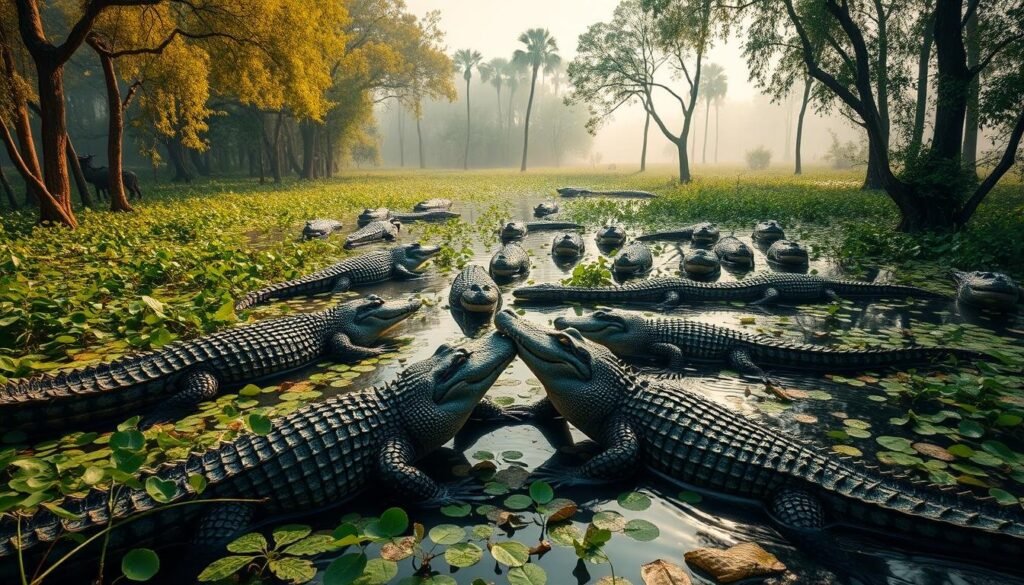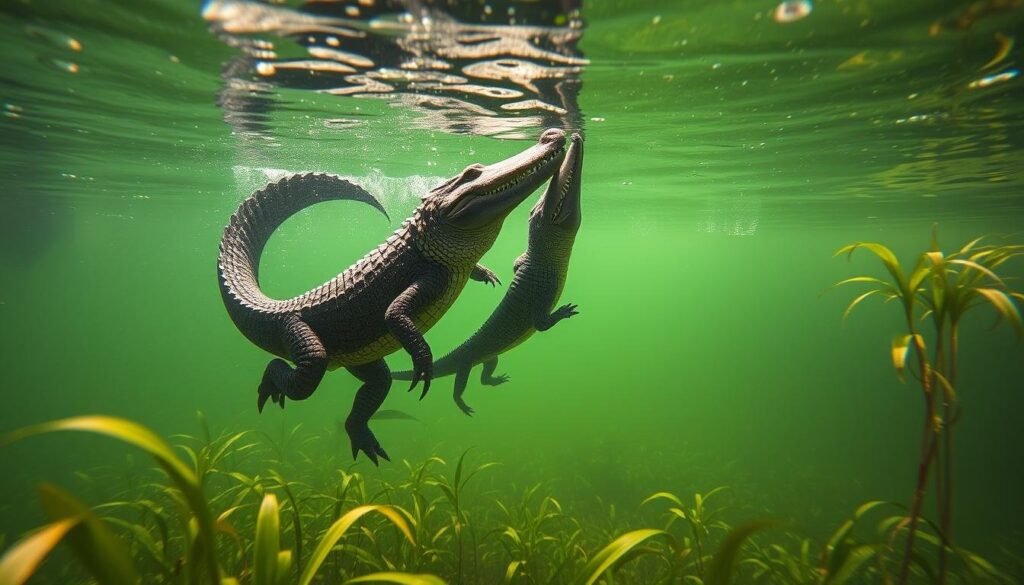Why Alligators Perform Mating Dances in Water? Have you seen the amazing alligator mating dances in the southeastern United States? This special ritual is key to the wildlife in these areas.
When it’s mating time, male alligators show off in a water courtship. They slap their heads, pose their bodies, and make loud bellows. They do this to prove they’re strong, big, and the best mate.
Watching these amazing animals, you’ll understand the complex social life in the wildlife of American wetlands better.
Contents
- 1 The Fascinating World of Alligator Courtship
- 2 Why Do Alligators Perform Mating Dances in Water?
- 3 The Choreography of Alligator Mating Dances
- 4 Biological Mechanisms Behind Alligator Mating Rituals
- 5 The Social Dynamics of Alligator Courtship
- 6 Regional Variations in Alligator Mating Behaviors
- 7 Observing Alligator Mating Dances Safely
- 8 Conclusion: Why Alligators Perform Mating Dances in Water?
- 9 FAQ
- 9.1 What is the primary purpose of alligator mating dances?
- 9.2 Where do alligators typically perform their mating dances?
- 9.3 What role do environmental cues play in initiating alligator courtship?
- 9.4 How do alligators use vibration transmission through water during mating dances?
- 9.5 What are some key factors that influence the choreography of alligator mating dances?
- 9.6 How do pressure sensors contribute to alligator mating rituals?
- 9.7 What adaptations have alligators made to human-altered waterways?
- 9.8 How can you safely observe alligator mating dances?
- 9.9 What are some regional variations in alligator mating behaviors?
- 9.10 How do female alligators respond to male displays during mating rituals?
The Fascinating World of Alligator Courtship
Alligator courtship is a captivating display of natural behavior. It is influenced by seasonal patterns and environmental cues. As you explore this complex ritual, you’ll gain a deeper understanding of the intricate dynamics at play.
Seasonal Patterns Across Different Regions
In the southeastern United States, alligator mating behaviors are shaped by regional seasonal patterns. For instance:
- In Florida, the courtship season typically begins in April.
- In Louisiana, it starts in May.
These regional variations highlight the adaptability of alligators to their local environments. [Why Alligators Perform Mating Dances in Water?]
Environmental Cues That Initiate Courtship
Environmental factors such as water temperature and vegetation play a crucial role in initiating alligator courtship. For example, rising water temperatures can signal the start of the mating season.
The key environmental cues include:
- Water temperature fluctuations.
- Changes in vegetation density.
By understanding these cues, you can better appreciate the complex interactions between alligators and their surroundings. [Why Alligators Perform Mating Dances in Water?]
Why Do Alligators Perform Mating Dances in Water?
Have you ever wondered why alligators do their mating dances in water? This behavior is key to their survival and finding a mate. It’s a complex mix of reasons.
Protection from Predators During Vulnerable Moments
Alligators are at risk during their mating dances. Water provides a relatively safe environment because it makes it hard for predators to move. This safety is crucial when they’re focused on finding a mate.
Energy Efficiency in Water vs. Land
Doing their mating dances in water saves alligators energy. Water makes it easier to move, helping them save energy for other important tasks. This efficiency is a big plus for their fitness.
Water is great for sending vibrations, which are key in alligator mating dances. These vibrations help them talk to potential mates and rivals. It’s a big part of their courtship.
Visual Displays Enhanced by Water Splashing
The water splashing makes their mating dances look even more impressive. This not only attracts mates but also keeps rivals away. The mix of movement and water splashing makes their dances captivating.
| Advantages | Description |
|---|---|
| Predator Protection | Water limits predator mobility, providing a safer environment. |
| Energy Efficiency | Water buoyancy reduces energy expenditure. |
| Vibration Transmission | Water effectively transmits vibrations for communication. |
| Visual Displays | Water splashing enhances the visual spectacle. |
The Choreography of Alligator Mating Dances
Exploring alligator courtship reveals a complex dance with coordinated movements. These dances are not just visually striking. They also involve a sophisticated use of sound.
A typical alligator mating dance starts with a male approaching a female. He then shows off his dominance through head-slapping and bellowing. [Why Alligators Perform Mating Dances in Water?]
Variations in Dance Intensity and Duration
The dance’s intensity and length can change a lot. This depends on other males around and the female’s mood. [Why Alligators Perform Mating Dances in Water?]
Bellowing Techniques and Their Meanings
Bellowing is key in alligator mating dances. It’s a way for them to communicate. Different bellowing sounds can mean different things, like aggression or courtship.
How Infrasound Travels Through Water
Infrasound, or sound waves too low for humans to hear, is important in alligator communication. These sounds can travel far through water. This helps alligators talk to each other over long distances.
| Aspect | Description |
|---|---|
| Sequence of Movements | Head-slapping and bellowing |
| Dance Intensity | Varies with context |
| Bellowing Techniques | Signals aggression or courtship |
| Infrasound | Facilitates long-distance communication |
Biological Mechanisms Behind Alligator Mating Rituals
Exploring alligator courtship reveals the detailed biological processes behind their mating rituals. These processes are essential for alligator mating success. They involve a variety of sensory abilities.
The biological mechanisms behind alligator mating rituals include:
- Sensory systems that detect vibrations in the water
- Visual adaptations that enable underwater courtship
- Specialized pressure sensors that play a key role in detecting movement
Pressure Sensors and Their Role in Detecting Movement
Alligators have pressure sensors that help them sense even the smallest water movements. This is crucial for their complex mating dances. These sensors are key to their underwater navigation. [Why Alligators Perform Mating Dances in Water?]
Visual Adaptations for Underwater Courtship
Alligators have visual adaptations for underwater courtship. Their eyes are designed to see well in dim light. This lets them perform their mating dances even in cloudy waters.
The mix of these biological mechanisms lets alligators carry out their detailed mating rituals. This ensures their species continues. By understanding these mechanisms, we can appreciate the complex biology behind these amazing behaviors.
The Social Dynamics of Alligator Courtship
Exploring alligator courtship reveals a complex social hierarchy. This hierarchy is key to their mating rituals. It involves hierarchy establishment through impressive water displays.
Hierarchy Establishment Through Water Displays
Dominant alligators show their strength through water displays. They splash and bellow to assert their dominance. These displays are vital in establishing a hierarchy among potential mates.
Combat Rituals and Their Outcomes
Combat rituals are a big part of alligator courtship. Males fight to prove who’s the strongest. The winner gets to mate, showing the value of strength and aggression.
Females pick their mates based on their displays and dominance. This choice is key to passing on strong genetic traits. It’s essential for the species’ survival.
Female Responses to Male Displays
Females decide whether to accept or reject males. Their choices are crucial for a male’s mating success. This shows the complex relationship between male displays and female responses.
Learning about these social dynamics helps us appreciate alligators’ courtship behaviors. It shows the complexity of their social interactions.
Regional Variations in Alligator Mating Behaviors
Did you know alligator mating dances change a lot in different places? The water environments they live in greatly affect their mating rituals.
Swamp vs. Lake Mating Behaviors
In swamps, alligators face more plants during their dances. This makes their courtship more complex. Lakes, with their open spaces, simplify their mating rituals.
Adaptations to Human-Altered Waterways
Alligators adapt well to human changes like canals and reservoirs. Their mating behaviors change to fit these new places, showing their strength.

| Environment | Mating Behavior Characteristics |
|---|---|
| Swamp | Complex courtship rituals, more vegetation |
| Lake | Simpler mating behaviors, more open spaces |
| Human-Altered Waterways | Adaptable mating behaviors, resilience |
Observing Alligator Mating Dances Safely
Watching alligator mating dances can be exciting if done right. It’s important to follow some rules to enjoy this without bothering the alligators. This way, you can see these amazing creatures without upsetting them.
Maintaining Safe Distances
It’s key to keep a safe distance from alligators. Maintain at least 20-30 feet away from them. This keeps you safe and lets the alligators stay calm. [Why Alligators Perform Mating Dances in Water?]
Photography Tips Without Disturbing Natural Behaviors
For photos, use a telephoto lens to get close without being too close. Don’t use flash, as it can scare them. Stay quiet and patient to not disrupt their natural actions.
| Tips for Observing Alligator Mating Dances | Benefits |
|---|---|
| Maintain safe distances | Ensures safety for both humans and alligators |
| Use telephoto lenses for photography | Captures intimate moments without disturbance |
| Avoid using flash | Prevents startling the alligators |
By sticking to these tips, you can watch alligator mating dances safely. This way, you respect these incredible animals and their home.
Conclusion: Why Alligators Perform Mating Dances in Water?
You now know about alligator mating dances, a key part of their life. These dances are not just interesting to watch. They are also vital for alligator survival.
Conserving these amazing creatures and their homes is essential. It helps keep ecosystems balanced where they live. [Why Alligators Perform Mating Dances in Water?]
Learning about alligators helps us support wildlife conservation. By backing efforts to protect their homes and learn about their dances, we help them thrive.
Think about how important it is to save our natural world. Your actions can really help protect alligators and their homes.
See Also: Why Do Rabbits Thump Their Hind Legs When Threatened?
FAQ
What is the primary purpose of alligator mating dances?
The main goal of alligator mating dances is to find a mate and show who’s in charge. [Why Alligators Perform Mating Dances in Water?]
Where do alligators typically perform their mating dances?
They usually do their mating dances in water. This can be in lakes, swamps, or marshes.
What role do environmental cues play in initiating alligator courtship?
Environmental cues like water temperature changes and daylight hours are key. They start the alligator courtship. [Why Alligators Perform Mating Dances in Water?]
How do alligators use vibration transmission through water during mating dances?
Alligators use vibrations in water to talk to potential mates and rivals. This makes their mating displays more effective.
What are some key factors that influence the choreography of alligator mating dances?
The dance’s choreography is shaped by several things. These include the order of movements, how intense and long the dance is, and the bellowing techniques used.
How do pressure sensors contribute to alligator mating rituals?
Pressure sensors help alligators detect movement. This is important for communication during their mating rituals. [Why Alligators Perform Mating Dances in Water?]
What adaptations have alligators made to human-altered waterways?
Alligators have changed their behavior and where they live to fit human-altered waterways. They show they can live in many different places.
How can you safely observe alligator mating dances?
To watch alligator mating dances safely, keep a safe distance. Don’t disturb them. Follow rules for watching wildlife responsibly. [Why Alligators Perform Mating Dances in Water?]
What are some regional variations in alligator mating behaviors?
Alligator mating behaviors vary by region. This includes differences between swamp and lake environments. They also adapt to human-altered waterways.
How do female alligators respond to male displays during mating rituals?
Female alligators show they’re ready to mate by changing their behavior or body language. They respond to male displays in subtle ways.

Zyair Larson, based in Denver, Colorado, has over 12 years of experience studying animal behavior. He has worked with the World Wildlife Fund (WWF) and National Geographic, researching wildlife and sharing insights on animal habits globally.

